The chances to succeed as an international student in the U.S.
An inside look to the international students' process to get an opportunity after studying in the U.S
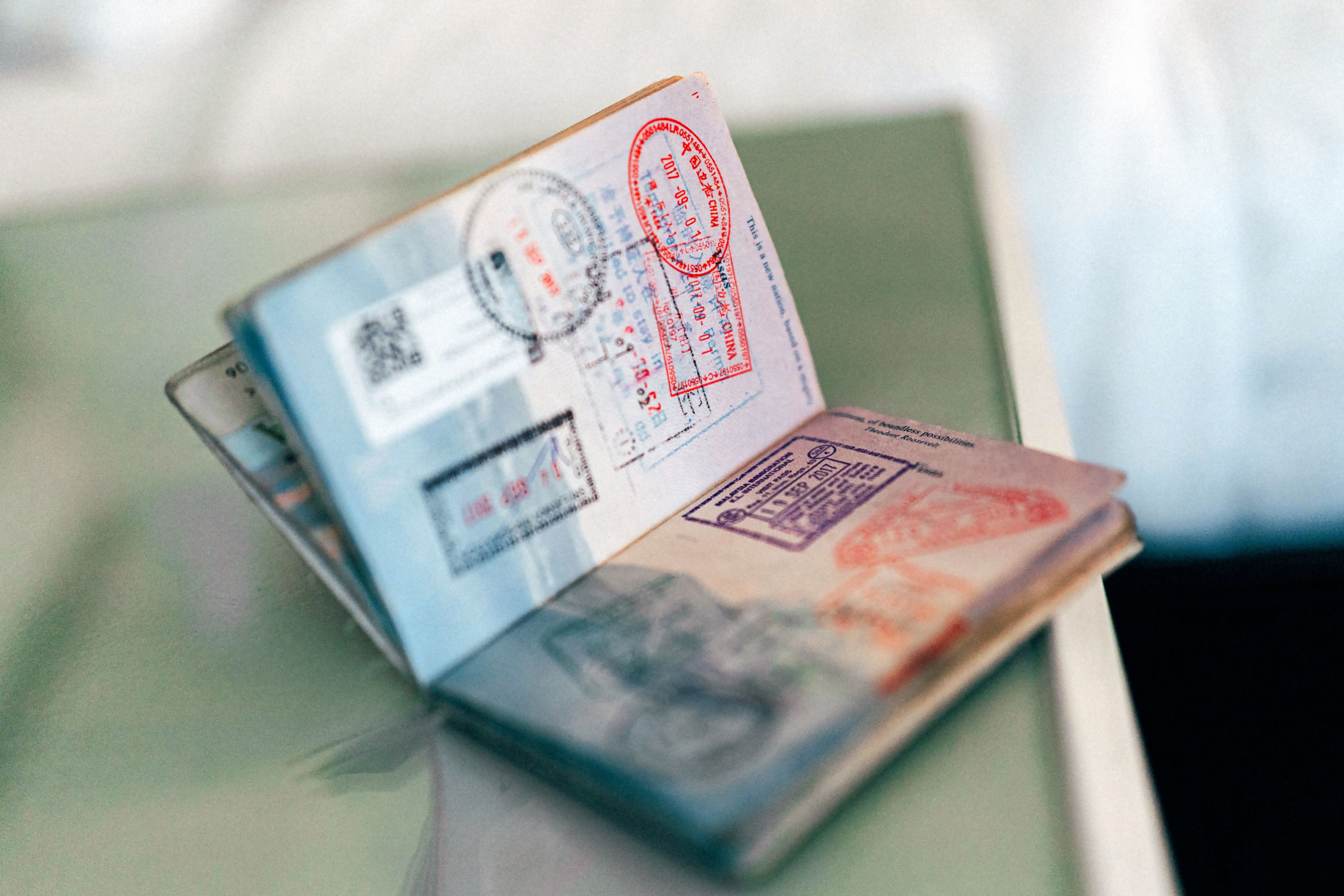
"It is a great opportunity, take advantage of it. Not everyone gets a chance like that, but dreams of it."
The United States is a country that provides opportunities for everyone. There have been a lot of successful stories in the past, these days and surely in the future. They came from hard work, sacrifice and taking advantage of the opportunity’s life presents to each one of us. These opportunities have raised the level of competition to get a job, which of course helps the companies to select the best candidates. At least that is what everybody would think, right?
That would be the ideal scenario for all students, competing against each other's experience, resume and skills developed after studying. Unfortunately, for international students that is not the case. There are conditions that limit the chances of these students to get an internship and a job.
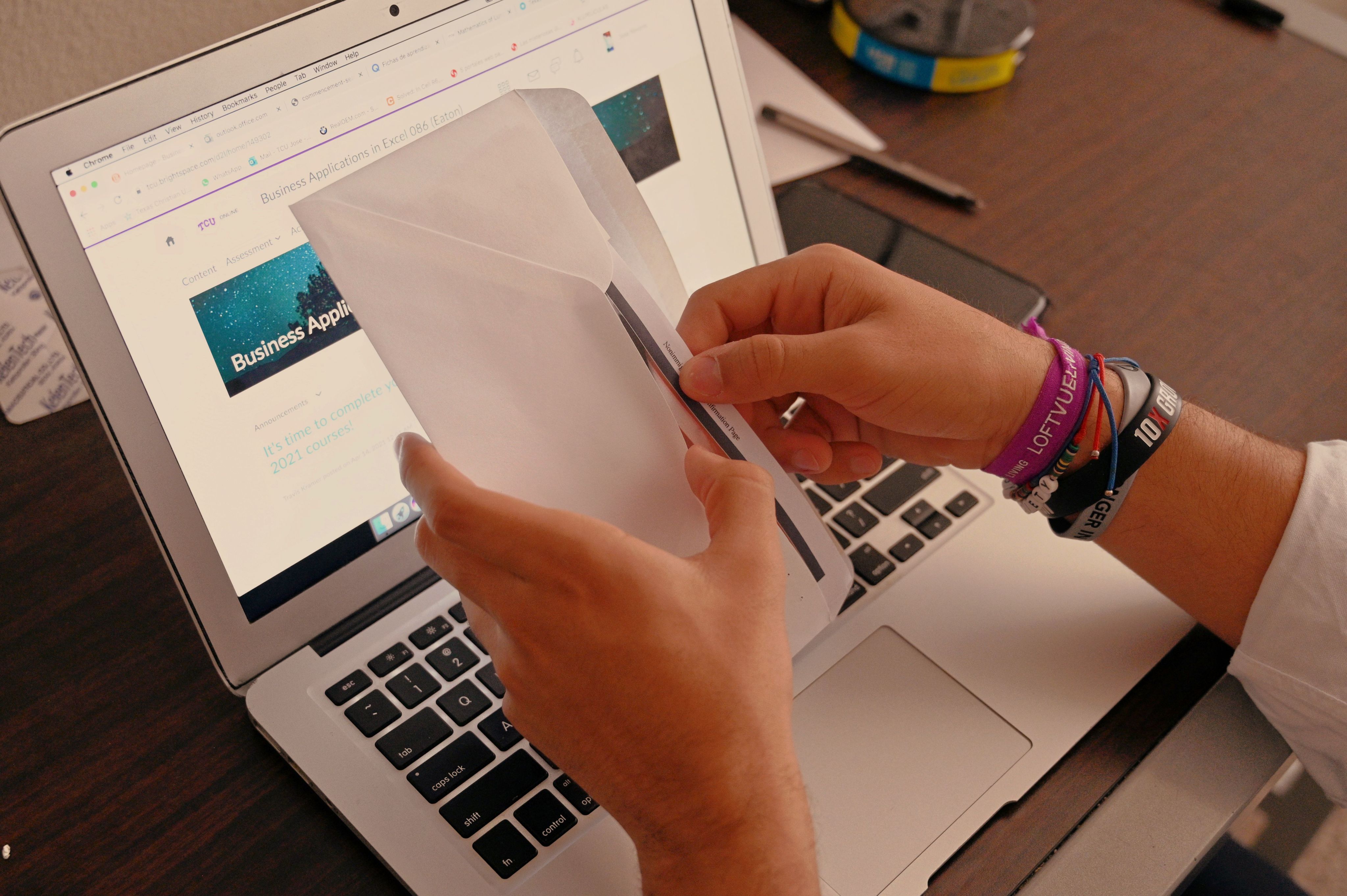
The process to get a job has different stages. Most of them start applying to an internship, hoping that it will become a job offer. It is clear that internships are meant to be learning experiences to keep improving as professionals, applying everything learned at the classroom into the real world.
Therefore, it is important to go step-by-step in the process that international students experience. The first thing they will hear about is Curricular Practical Training (CPT).
CPT is any alternative work/study, internship, cooperative education, or other type of required internship or practicum offered by sponsoring employers through cooperative agreements with the school. CPT must be an integral part of an established curriculum. These students should enter the CPT employment end date from the employment authorization section of their Form I-20 in Section 1 as the date employment authorization expires.
The CPT will allow international students to start their career path in the United States, if they get an internship that accepts it. According to Zippia, an online recruitment platform, 70% of the students are hired by the company they interned for. The problem is that not every company accepts CPT candidates, therefore international students start losing their chances.
These students start their first round to get a job with a broken finger, already at a disadvantage. Logically, juniors and seniors are more experienced, and interviewing them got me to stories of success and disappointments. Most of them agreed these continuous job search experiences, allowed them to keep growing and strengthened their resiliency.
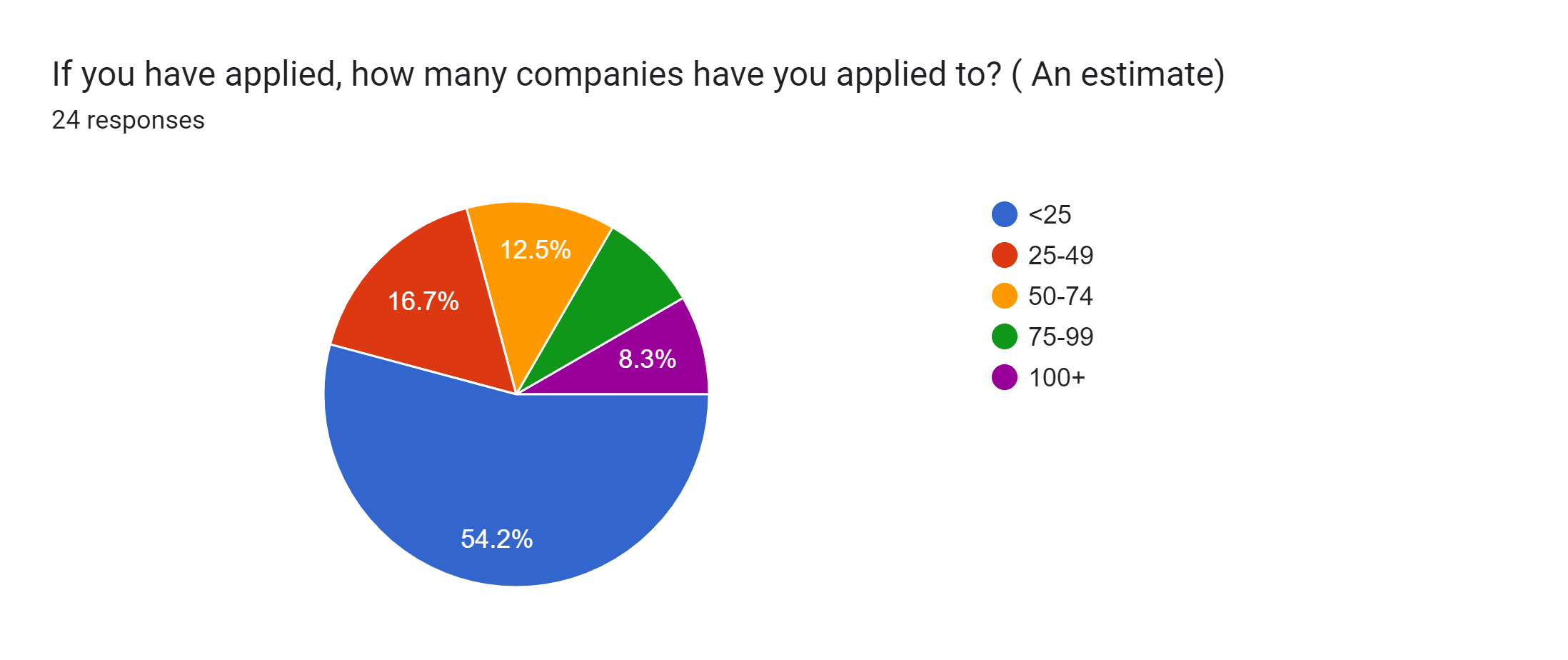
Survey Responses by 3rd and 4th year students.
Survey Responses by 3rd and 4th year students.
This is the starting point, and it has already become a problem for some of them. In the words of a 3rd Year student at TCU.
"I had already passed the interviewing rounds and the company said I was going to receive the offer letter a certain day. I waited, the offer never arrived. I called to figure out what happened, and I was told they could not take me because of the CPT."

The quote represents many of the international students in the U.S, and the situation will continue repeating. According to 3rd and 4th year international students, most companies that have been at recent TCU Career Fairs are not informed on the subject. Therefore, most of the interviews with international students end with a recruiter's "I will let you know".
The situation does not improve, but getting an internship increases their chances to get a job. Zippia affirms that individuals have a better chance of getting hired if they have an internship experience. According to this source the average of seniors that receive an offer after an internship experience is around 53.2%.
Whether or not the student gets an internship, the next step is to find a job. The student has to compete against candidates who had an internship and will not require sponsorship on the limited number of companies that accept OPT.
Not every company accepts OPT, but those who do accept it do not necessarily sponsor H-1B Visas.
To understand this, it is important to define both and how they affect the process. After CPT, the following step is to get a job offer from a company that accepts Optional practical training (OPT).
What is the Optional practical training (OPT)?
OPT provides a practical training experience that directly relates to an F-1 student’s major area of study. Foreign students in F-1 nonimmigrant status participating in OPT must obtain an EAD from USCIS before they are authorized to work. The student may not begin employment until the date indicated on the EAD.
The OPT has its exceptions such as F-1 students who received a bachelor’s, master’s, or doctoral degree in science, technology, engineering or mathematics (STEM) from an accredited Student and Exchange Visitor Program-certified school may apply for an extension of their OPT while in a period of post-completion OPT.
Unfortunately, it is not a guarantee, but it does help increase the chances. I have interviewed engineering students that were already enrolled in a Master's program because they couldn't find a job, but fortunately found a job in the last couple of weeks.
Time is something that international students have against, they must apply for OPT up to 90 days before and up to 60 days after your expected graduation date.
Once the student has a job that accepted OPT, the timer begins and depending on the career and in most of the cases it is set to 12 months. Once the year of permission is over it is time to move into the H-1B Visa process and lottery.

The H-1B VISA
The H-1B visa is a nonimmigrant work visa that allows U.S. employers to hire foreign workers with specialized skills to work in the United States for a specific period of time. Typically, the roles require a bachelor’s degree or equivalent. Occupations that qualify for the H-1B visa are typically in fields such as technology, finance, engineering, architecture, or more.
Initial Registration Process
How does it work?
It is a lottery. Yes, it is a random lottery selection process between hundreds of thousands of applicants per year. According to VISANATION, here is a brief explanation of how the approved registrations are selected.
The computer-generated selection process picks 65,000 from the entire pool . Those that were not accepted and were eligible for the advanced degree exemption were transferred to the master’s cap pool for a second chance at selection. USCIS has stated that your odds of selection as an advanced-degree holder increase by up to 16% .
This is the greatest obstacle for international students after their OPT is over. Their 4-year investments is placed into a lottery that randomly selects the subjects receiving the H-1B Visa. Understanding all of these is what allows to understand the pressure, stress, and difficulties these students go through. These explanations enhance the odds and the real chances of succeeding in the United States.
Less than 1 out of every 5.6 H-1B cap registrations received by the USCIS during the H-1B cap registration period between March 1 and March 18, 2022, were selected in the H1B lottery 2023.
All these basic concepts and explanations are the foundations of the situation, here is an easy but clear example of how the chances to succeed as an international student decline.
The balance starts going against the international students the moment they start applying filters to recruitment platforms. Handshake, an online recruiting platform has the filters that allowed me to demonstrate how rapidly the odds to find an opportunity change.
On the first image, we see that there are 16,532 jobs . This number of jobs are offered without applying filters in the platform today, a considerable number that could easily amaze an international student.
After the first filter is applied, the jobs decline. The work authorization filters that are made for these students quickly erased 13,155 job opportunities.
The number was reduced so much, that I decided to apply each filter by itself until the end. On the third image the second filter is applied, even though the number increased, if compared to the first image it is still a very reduced quantity from the original amount.
The previous explanations about these conditionings transformed into filters, represent the real situation these students face. If both filters are applied, it is meant to find an opportunity that works with CPT, OPT and that in the future will sponsor the H-1B Visa.
The number was reduced by 14,997 jobs after both filters were applied, leaving only 1555 jobs that could be the ideal scenario for international students. This final number is without applying major filters, desired locations, and it includes unpaid internships as well.
The odds decreased by 90.6% for international students with those filters, meaning that approximately only 1 in 10 jobs could be offered to an international student. It is important to remember that this 1 job is not meant for them, U.S citizens and candidates with legal permission to work are competing for that position as well.

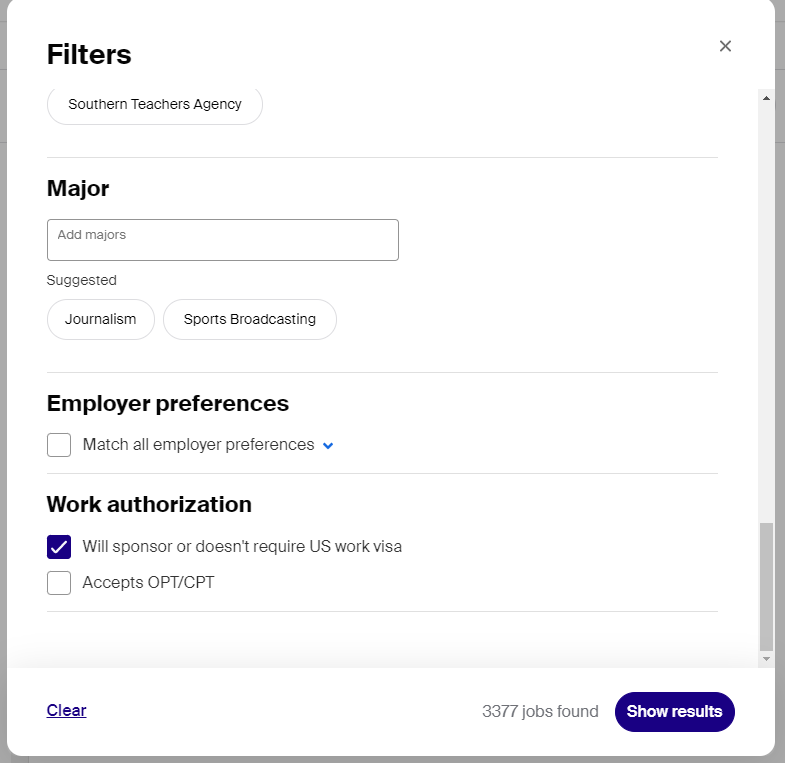
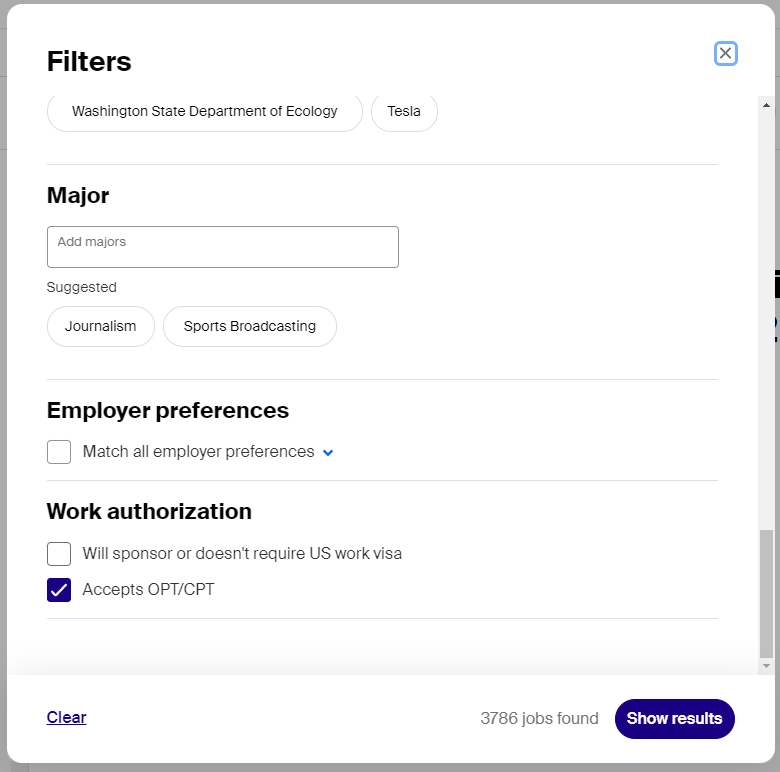
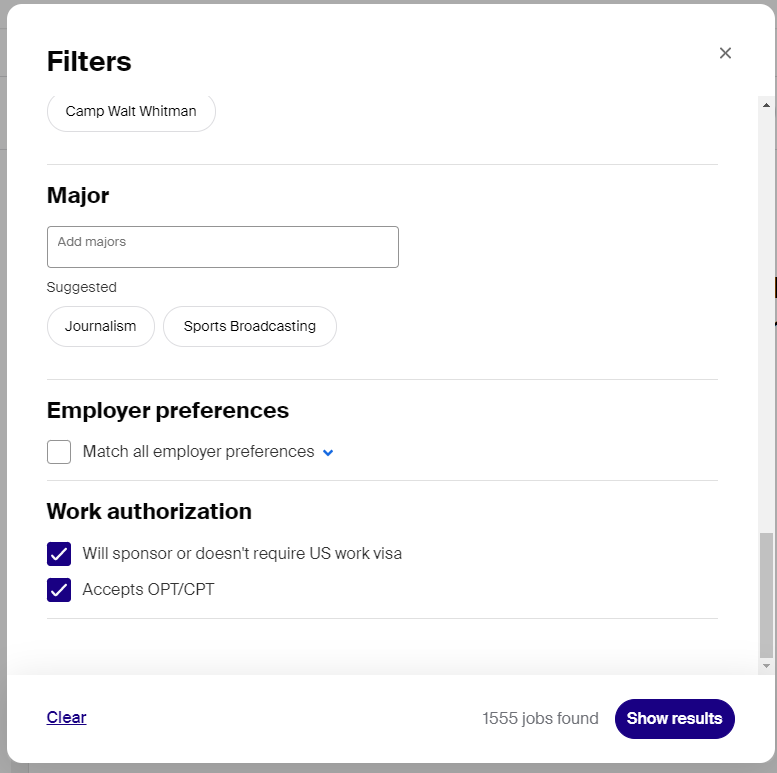
The international students' perspective
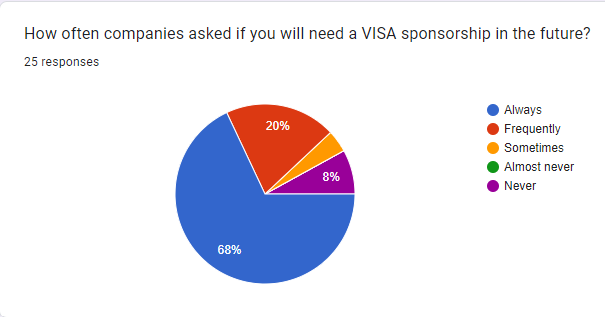
68% of the students in the survey agreed they have always been asked about the visa sponsorship on their application.
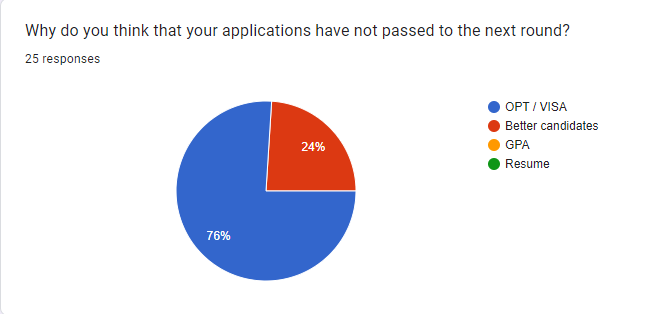
76% of the students agreed they have not been through the first round of selection because of the immigration conditionings.
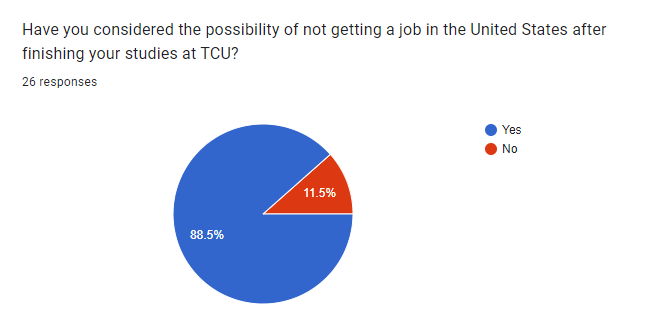
88.5% of the international students that responded the survey have considered the possibility of not get a job in the U.S after graduating.
After all these processes, is there a real chance to succeed in the U.S as an international student?
Yes, there is a chance. The competition for international students is higher, the spots are limited and even after getting their jobs, the H-1B Visa lottery could be the end of the journey.
Nevertheless, the 56% of the students who responded the survey got an internship/job offer after an undefined number of applications through the years. Only the 4% got multiple offers, a percentage that demonstrates how rare it is.
The difficulties are high in terms of finding a job but the current working visa selection method is the biggest obstacle. According to USCIS, from 758, 994 eligible registrations, only 110,791 were selected and only 65,000 can get approved.
Therefore, as a registered subject for H-1B Visa you only have a 58.6% probability of getting your visa approved as an undergraduate.
This is the process that international students go through during their college days and it will not change today or tomorrow. The opportunities are there, difficult to find but they do exist. Hopefully, for international students the odds will be different for the future generations and they will have an easier way to succeed in the United States.
References
- US Citizenship and Immigration Services. (n.d.). H-1B electronic registration process. Retrieved May 5, 2023, from https://www.uscis.gov/working-in-the-united-states/temporary-workers/h-1b-specialty-occupations-and-fashion-models/h-1b-electronic-registration-process
- VISANATION. (2016, May 2). H1B lottery 2016 results, chances, process. Retrieved May 5, 2023, from https://www.immi-usa.com/h1b-lottery-2016-results-chances-process/#:~:text=Looking%20Back%20at%20Past%20H,a%2013%25%20chance%20of%20selection.
- Zippia. (n.d.). Internship Statistics: What You Need to Know. Retrieved May 5, 2023, from https://www.zippia.com/advice/internship-statistics/#:~:text=70%25%20of%20all%20interns%20are,after%20completing%20their%20training%20period.
- US Citizenship and Immigration Services. (n.d.). Foreign academic students. Retrieved May 5, 2023, from https://www.uscis.gov/i-9-central/complete-correct-form-i-9/completing-section-1-employee-information-and-attestation/foreign-academic-students
- Anderson, S. (2023, May 1). Immigration Service Likely To Change H-1B Visa Lottery. Forbes. Retrieved May 5, 2023, from https://www.forbes.com/sites/stuartanderson/2023/05/01/immigration-service-likely-to-change-h-1b-visa-lottery/?sh=7ea2d8e42868
- VisaPro. (n.d.). H1B Visa Lottery. Retrieved May 5, 2023, from https://www.visapro.com/resources/article/h1b-visa-lottery/
- VISANATION. (n.d.). H-1B Cap. Retrieved May 5, 2023, from https://www.immi-usa.com/h1b-visa/h-1b-cap/
- Boundless. (n.d.). The H-1B Visa Explained. Retrieved May 5, 2023, from https://www.boundless.com/immigration-resources/the-h-1b-visa-explained/#h1b-visa-eligibility
- Prosperity for America. (n.d.). International Students in the US. Retrieved May 5, 2023, from https://www.prosperityforamerica.org/international-students-in-the-us/#ftoc-heading-1
